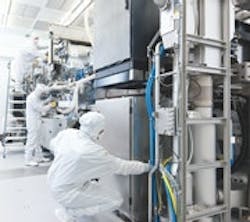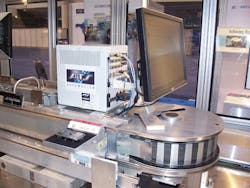Surpassing System Integration
Machine builders and system integrators do lots of unexpected jobs to serve their end users, but even the most innovative can't design and build their own industrial computers, right? Wrong.
In fact, legendary system integrator ATS Automation (www.atsautomation.com) in Cambridge, Ontario, recently constructed its own industrial computer from scratch to better coordinate its 12-year-old Supertrak conveyor with its 3-year-old Smart Vision system. ATS exhibited its year-old Cortex computer at the recent ProMat/Automate 2011 show at McCormick Place in Chicago.
"We had a vision for a long time that this kind of enhancement would enable Supertrak to be applied in even higher-speed production by using a PC to help our vision system capture images, calculate positioning instructions, and communicate with the conveyor at the sub-1-second speeds," says Mitch Coleman, global account manager for transportation for ATW Automation (www.assembly-testww.com) in Dayton, Ohio, an ATS subsidiary. Supertrak's pallets are controlled individually, and can each change speed and acceleration with full collision avoidance. These higher-speed applications include electronic assembly, automotive parts, pharmaceuticals and solar components.
"We developed our own vision libraries internally over 25-30 years, and they included a lot of the basics of inspection and robot guidance, but they were on a QNX platform that was harder for customers to use because of the knowledge and training required," says Paul Sommers, ATS's vision engineer. "So, a few years ago, we ported these libraries and converted them to Windows, added a user-friendly GUI and called it Smart Vision. So far it's sold about 2,000 licenses."
However, because ATS and its engineers just can't help thinking like system integrators, and still focus on the tools their users need, Sommers says they noticed that most vision systems gave users libraries and untreated vision signals, but didn't provide the supporting tools needed to make those signals easy to integrate with a PLC and work well in a machine.
"As a result, we began making an integrated package for Smart Vision that included all its TCP/IP communications, lighting controls, frame grabber, Power over Ethernet and other functions, so users could create an inspection sequence by just using the GUI without a lot of programming," Sommers says. "The computer took about a year to develop, and evolved from our internal standards. We were able find all the robust components we wanted to put into it, and these helped us reduce design time and wiring costs, and put it all in a much smaller cabinet. We did have some internal debates about building our own PC, but we were able to show that it could reduce many costs for users designing and integrating their own machines."
Cortex 812 includes eight Ethernet-based Optcon cameras, 12 lights and outputs, internal compact-flash data storage, external USB-based data backup, and a C6920 central processor from Beckhoff Automation (www.beckhoff.com). On the output side, it has two LAN ports that connect via Profibus to Supertrak's PLCs. A second model, Cortex 214, has two cameras. "It even has a regular 120 V power extension, so the user's vision guys can integrate their system before a machine is wired and powered up, and this can make scheduling easier and save even more time," Sommers adds.
However, ATS didn't stop there, and reports that it has also gone beyond the traditional SI role of building tools for individual projects to begin offering Cortex, Smart Vision and Supertrak for sale as individual, off-the-shelf products.
Transitioning from being just a machine builder and integrator to also being a components supplier has been a pretty major corporate mind shift for ATS, but its engineers resolve their old and new roles by realizing they're all part of serving their end users. "In the past, manufacturers would come to us with functions they needed to accomplish, and so we completed projects and only sold internally developed products on machines that ATS built and sold," Sommers says. "The computer we previously used for Smart Vision and Supertrak had devices spread out all over the production line, and so we couldn't just take it out. Now, we have all these functions in one computer, and can slide it in as needed."


